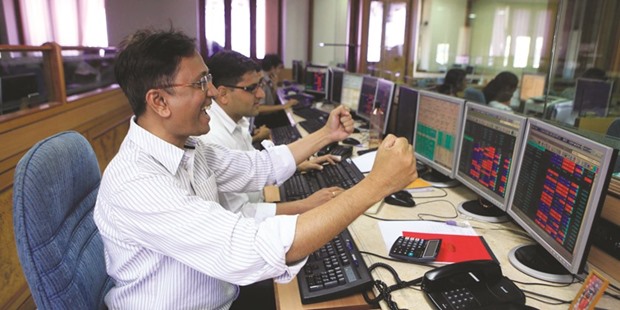Indian stocks rebounded from its worst week since 2009 as regional markets rallied amid speculation losses that triggered a bear market were excessive.
Tata Steel climbed the most since May 2009. State Bank of India had the steepest gain in 20 months, while Bank of Baroda, the third-biggest lender by assets, soared 23% from a two-year low. Reliance Industries, owner of the world’s largest refining complex, rose the most in six months. A gauge of property developers climbed from a record low.
The S&P BSE Sensex jumped 2.5%, with seven of the 30 stocks in the benchmark index climbing more than 5% each. The gauge slumped 6.6% last week to enter a bear market. The selloff, which erased $245bn from stocks’ value since January 1, sent the index’s 14-day relative strength index on Friday to below the 30 level that some analysts say signals a rebound is due.
“The markets were in an oversold zone, both locally and globally, and a rebound was on the cards,” Alex Mathews, the head of research at Geojit BNP Paribas Financial Services, said by phone from Kerala. “The mood is still very cautious. All eyes will be on the budget and cues from the global markets.” Finance Minister Arun Jaitley will present the budget on February 29. Economists surveyed by Bloomberg expect him to meet the government’s fiscal deficit target for the year ending March 31, while slightly pushing back next year’s goal to 3.6% of gross domestic product. The Reserve Bank of India left borrowing costs unchanged this month after four cuts in 2015, with governor Raghuram Rajan saying that his next move would depend on inflationary trends and the federal budget.
Bank of Baroda reported on Saturday loss of Rs33.4bn ($490mn), the largest in at least a decade as provisions for bad loans tripled. Analysts had estimated a profit of Rs5.35bn. The shares had their best-ever rally, as investors were buoyed by comments made by chief executive officer PS Jayakumar after the earnings report.
“The market is rooting for Bank of Baroda as it decided not to kick the can down the road by fully providing for all stressed assets at one go,” Hatim Broachwala, Mumbai-based banking analyst at Nirmal Bang Institutional Equities, said by phone. “Profit and asset quality at the lender is expected to remain robust from here on.” Tata Steel soared 13% to pare this year’s loss to 5%. State Bank rallied 8.4%, the most since May 2014. Reliance climbed 4.4%. Larsen & Toubro, the largest engineering company, added 9.1%, the steepest gain since May 2009.
Global funds sold a net $178mn of Indian stocks on February 11, taking this year’s outflow to $2.1bn. They bought $3.3bn of shares last year, the smallest in four years.
The Sensex has plunged 10% this year and trades at 14.7 times its projected 12-month earnings, compared with a multiple of 10.4 for the MSCI Emerging Markets Index.
Meanwhile, the rupee rose 0.3%, the most since February 4, to 68.06 a dollar in Mumbai, according to prices from local banks compiled by Bloomberg. It fell to as low as 68.4725 on Friday, near a record 68.845 seen in August 2013. A certain amount of depreciation in the currency is necessary to ensure India doesn’t become uncompetitive, Rajan said over the weekend.

Stock traders at a brokerage firm in Mumbai. The Sensex rose 2.5% yesterday.


